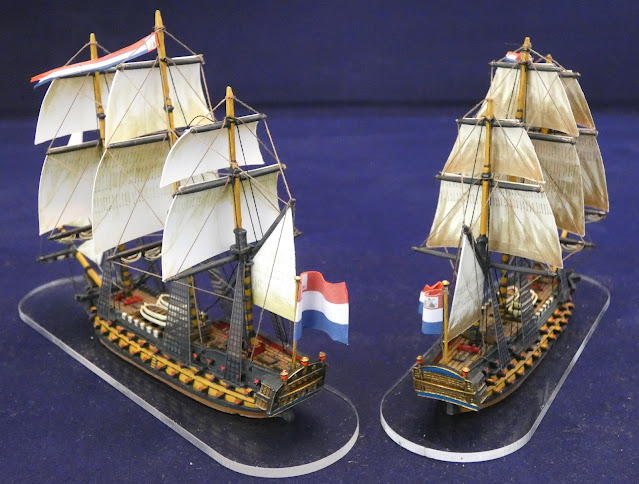An important stage in my Camperdown Project Build started last October 2023 was reached this week and the plan to bring the battle to the table in glorious 1:700 scale moved a little closer.
The first part of this little project is now finished with the completion of the last two models in the Batavian Battle Line and thus all sixteen are ready for battle with work now progressing to the British Windward Division and the three British 74-gun third rates, Venerable, Triumph and Bedford.
 |
| My models representing the 68-gun Gelijkheid and 56-gun Beschermer. |
Once the two fleets are finished I'll do a bit of a fleet review with all the models together prior to organising the first full run through of this famous British naval victory that, together with the victory at Cape St. Vincent fought earlier in 1797 on the 14th February, gave Britain the initiative in the naval struggle of the French Revolutionary War.
So as per normal I present these two Batavian ships of the line, their statistics and recorded history.
Beschermer
Beschermer was a 56-gun fourth-rate laid down in 1781 and launched in 1784 by the Admiralty of West Friesland, which was one of the five admiralties of the Dutch Republic, made up of West Friesland, a region in the north of Holland.
Her general characteristics were:
Tons burthen 1052 tons (bm)
Length of gundeck 145 feet, 1 inch
Beam 40 feet, 10 inches
Depth of hold 16 feet, 4 inches
Her armament consisted of:
Gundeck: 24 x 18-pounder long guns
Upper Gundeck: 24 x 12-pounder long guns
Quarterdeck & Forecastle: 8 x 8-pounders long guns
In 1795 she became part of the Batavian Navy, following the French invasion of the Netherlands.
As seen in the map above, Beschermer drew the attention of HMS Lancaster under Captain John Wells firing on the Beschermer near the head of the Dutch line. Aware that their vessel would be unable to resist the attack, Beschermer's surviving officers turned away towards the shore, rapidly followed by the unengaged portions of the Dutch line.
On the 11th October 1797 Beschermer took part in the Battle of Camperdown under Kapitein ter Zee Dooitze Eelkes Hinxt. The ship escaped the battle with light damage this after Hinxt was severely wounded.
On the 30th August 1799 Beschermer, under Captain Eilbrach, was surrendered to the British during the Vlieter Incident.
Gelijkheid was a 68-gun third-rate laid down in June 1777 and launched in 1788 by the Admiralty of Rotterdam, also called the Admiralty of the Meuse, which was one of the five admiralties of the Dutch Republic.
 |
| The 's-Landswerf in Rotterdam |
Originally named Prins Frederik Willem she was renamed Gelijkheid (Equality) in 1795, joining the new Batavian Republic fleet.
Her general characteristics were:
Tons burthen ? tons (bm)
Length of gundeck 155 feet, 1 inch
Beam 42 feet, 10 inches
Depth of hold 18 feet, 7 inches
Her armament consisted of:
Gundeck: 26 x 32-pounder long guns
Upper Gundeck: 26 x 18-pounder long guns
Quarterdeck & Forecastle: 16 x 8-pounders long guns
On 11 October 1797 the Gelijkheid took part in the Battle of Camperdown under Kapitein ter Zee H. A. Ruijsch. The ship was badly damaged and may have been dismasted, losing forty men killed when she finally struck at about 15.10.
The map below shows the battle in its early stage as the Batavian rear has been fully engaged by the British Leeward Division as the Windward Division starts to close in with HMS Ardent and Venerable already hotly engaged with the Vrijheid and Staten Generaal.
The battered Wassenaar surrendered for the second time, to Russell, while Admiraal Tjerk Hiddes De Vries and Gelijkheid, both of which were too badly damaged to escape, also struck their colours. Eventually only the Dutch flagship remained in combat until finally boarded by HMS Director.
This concludes my look at the ships making up the Batavian Dutch Battle line. In the next post I'll take a look at the British 74's Venerable, Triumph and Bedford together with a look at the career of the British commander Admiral Adam Duncan and his management of the battle.
More anon
JJ




















By god sir they are simply stunning models. I am not at all jealous. I am too much in awe for that. With best wishes.
ReplyDeleteThank you, that's very kind. I'm looking forward to seeing the collection complete and on the table ready to play.
DeleteJJ